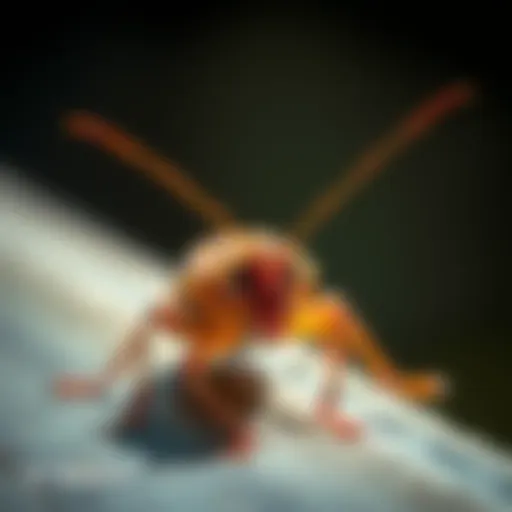Effective Strategies to Deter Raccoons from Your Property


Intro
Raccoons are often seen as charming creatures, but they can turn into significant nuisances when they invade gardens and homes. Understanding raccoon behavior is essential for homeowners who wish to deter these pests effectively. This article delves into various strategies that individuals can employ to keep raccoons at bay. A comprehensive approach that incorporates noise, light, scents, and physical barriers will be explored. Additionally, the importance of eco-friendly solutions cannot be overlooked. Let's begin by examining the broader context of dealing with these animals.
Understanding Pests
Definition of Pests
Pests are organisms that negatively affect human activities, often in the context of agriculture or property management. Raccoons fit into this category as they can cause damage to homes, gardens, and local ecosystems. They are opportunistic feeders, drawn to easy food sources, which often leads them into conflict with humans.
Importance of Pest Identification
Accurate identification of pests is crucial. Recognizing what species is causing the disturbance can help tailor the response effectively. Raccoons are distinguishable by their ringed tails and masked faces. Understanding their habits, such as nighttime foraging and preference for sweet or high-fat foods, provides insights into their behavior, allowing property owners to anticipate and prevent invasions.
Prevention Techniques
Home and Garden Preventative Measures
Several practical measures can deter raccoons from invading your home and garden.
- Secure Garbage Cans: Ensure that trash bins have tight-fitting lids and are stored in a secure area.
- Remove Food Sources: Bird feeders should be taken down at night. Also, consider using raccoon-proof feeders if leaving them up is essential.
- Seal Entry Points: Inspect your home for holes or gaps, especially in attics, basements, and crawl spaces. Seal these with durable materials to prevent raccoon access.
- Install Motion Sensors: Motion-activated lights can startle raccoons and discourage them from approaching.
Seasonal Prevention Tips
During different seasons, raccoons may exhibit varying behaviors. Adjusting your strategies according to seasonal changes can enhance prevention efforts.
- Spring and Summer: These warmer months see raccoons foraging for food more actively. Ensure outdoor pet food is brought in at night.
- Fall: Raccoons prepare for winter by searching for warmer shelter and food. Increase vigilance against entry into attics and basements during this time.
- Winter: While raccoons hibernate, some may still be active. Regular inspections should be conducted to secure any possible entrances into your home.
Eco-Friendly Pest Control Solutions
Overview of Sustainable Practices
Eco-friendly approaches to pest control focus on preventing animal intrusions without harming wildlife. Raccoons, like all creatures, play a role in the ecosystem. Thus, strategies should aim to redirect their behavior rather than eliminate them.
Natural Remedies and Their Effectiveness
Certain natural repellents can deter raccoons effectively. Some options include:
- Cayenne Pepper: Sprinkling this spice around the garden can deter raccoons due to its strong scent and irritating properties.
- Vinegar: Soaking rags in vinegar and placing them around areas prone to invasion can deter raccoons as they dislike the smell.
- Essential Oils: Scents such as peppermint or eucalyptus can be effective repellents when used in a spray form around the property.
While these natural remedies may not be foolproof, they offer alternatives to harsher chemical solutions, promoting a more sustainable approach to wildlife management.
By understanding raccoons and employing comprehensive, eco-friendly strategies, homeowners can protect their properties while coexisting with nature. It’s crucial to combine knowledge about raccoon behavior with practical preventive measures to achieve lasting results.
Understanding Raccoon Behavior
Understanding the behavior of raccoons is crucial for developing effective strategies to deter them. Their habits, preferences, and social structures play a significant role in how they interact with human environments. By gaining insights into these elements, homeowners can implement targeted deterrent measures that are more likely to succeed.
Habitat Preferences
Raccoons tend to thrive in diverse environments, which makes them adaptable and resourceful. They often favor areas close to water sources, such as rivers and lakes, as these locations provide abundant food and shelter. Urban areas also attract raccoons due to the presence of easily accessible food waste and convenient hiding spots like dumpsters or abandoned buildings. Understanding these habitat preferences helps homeowners identify potential vulnerabilities and locations where raccoons might invade their properties.
Dietary Habits
Diet is a fundamental aspect of raccoon behavior. Raccoons are omnivorous creatures, enjoying a varied diet that includes fruits, vegetables, insects, and small animals. However, they are particularly drawn to human food sources. This can include garbage, pet food left outside, or unsecured compost bins. Recognizing their dietary habits informs homeowners about what attracts raccoons and enables them to adjust their waste management practices to deter these critters from foraging.
Social Structure
Raccoons have distinct social behaviors that impact their foraging and nesting habits. Typically, they are solitary animals but can form small groups when food is plentiful. Males and females may come together primarily during mating seasons. Knowledge of their social structure is important to understand invasion patterns and behaviors. For instance, during certain times of the year, like spring and summer, the presence of young raccoons may increase, leading to more frequent visits to residential areas as they learn to explore their surroundings.
Understanding raccoon behavior not only aids in effective deterrence measures but also fosters a deeper respect for their role in the ecosystem.
The insights gained from studying raccoon behavior form the foundation for implementing effective deterrent strategies. The combination of their habitat preferences, dietary habits, and social structures provides a clearer picture of their interactions with our spaces.
Characteristics of Raccoons That Encourage Home Visits
Understanding the characteristics of raccoons is fundamental in the effort to deter them from invading homes and properties. Raccoons exhibit particular behaviors and traits that drive their attraction to human environments. By recognizing these aspects, homeowners can formulate more effective strategies to keep these creatures at bay.
Nocturnal Nature
Raccoons are primarily nocturnal animals, meaning they are most active during the night. This tendency offers them a significant advantage as they navigate urban and suburban landscapes largely undisturbed by humans. Nighttime provides a cover for foraging, exploring, and potentially raiding garbage cans or bird feeders.
The implications of their nocturnal behavior are profound. Homeowners should realize that raccoons are likely more prevalent during darker hours. This understanding can inform when to implement deterrents effectively. For example, increased noise during nighttime or motion-activated lights may disrupt their activities when they are most active.
Curiosity and Intelligence
Raccoons possess a keen sense of curiosity and remarkable intelligence. Known for their dexterous forepaws, these animals can open containers, unfasten latches, and explore intricate spaces. This adaptability allows them to investigate new environments, including residential areas. Their intelligence makes them challenging to deter with conventional methods.
Their curiosity drives them to explore different sources of food, which often leads them to homes. It is critical for homeowners to limit easy access to food sources such as pet food left outside or unsecured trash. Understanding raccoons' curiosity can lead to preemptive strategies that make properties less appealing.
"Recognizing and understanding raccoon behavior is key to developing an effective deterrent strategy."
In summary, the characteristics of raccoons that encourage them to visit homes revolve around their nocturnal patterns and their innate curiosity. By leveraging this knowledge, homeowners can adopt a more targeted approach to deterrence, ensuring their properties remain raccoon-free.
Auditory Deterrents


Auditory deterrents play a crucial role in preventing raccoons from encroaching on residential properties. By exploring this method, homeowners can harness the natural instincts of raccoons. These creatures are generally skittish and can be startled by loud or unfamiliar sounds. Therefore, deterring them with strategic auditory signals can significantly reduce their presence near homes.
Choosing the right noises is essential. Homeowners can employ loud, sudden sounds or even sustained auditory signals, which are effective in keeping raccoons at bay. The idea is to associate the unpleasant sounds with their presence, creating a negative experience that will discourage future visits.
Loud Noises
Using loud noises is one of the most basic forms of auditory deterrents. This can include anything from honking horns to banging pots. The unexpected nature of these sounds can disrupt raccoons’ behavior. A sudden noise can lead them to perceive the area as risky or unsafe.
Residents can also consider more permanent solutions. Motion-activated devices that emit loud noises upon detecting movement can be particularly effective. They can create an immediate deterrent effect, ensuring that raccoons think twice before approaching again. However, homeowners must be mindful of the impact on nearby people and pets—excessive noise can disturb not only wildlife but also neighbors.
Ultrasonic Devices
Ultrasonic devices are modern technology's answer to raccoon deterrence. These devices emit high-frequency sounds that are typically inaudible to humans but can be distressing to raccoons. They are designed to be effective without causing harm or significant disturbance to the environment.
Homeowners may find that these devices are easy to install and operate. Many models are solar-powered, which allows them to function continuously without the need for electrical outlets. It is important to position the device strategically to maximize its effectiveness. Regularly assessing the device's functionality and ongoing effectiveness will help ensure that it maintains deterrent capabilities.
Natural Predatory Sounds
With raccoons being natural prey for larger predators, emitting sounds that mimic these creatures can instill fear in them. Sounds of animals like coyotes or owls can be recorded and played periodically in backyards. This strategy taps into the raccoon’s innate survival instincts.
Emulating these natural sounds can be managed through various devices or apps that simulate wildlife calls. Homeowners can integrate this strategy into their existing pest management activities. Being mindful not to overwhelm the area with sounds is necessary, as raccoons may adapt to consistent exposure. It is advisable to play these sounds intermittently rather than continuously, to heighten the element of surprise.
"Effective use of auditory deterrents can transform the way homeowners protect their properties from raccoons. Not only do these methods prove useful, they also align with sustainable wildlife management practices."
Visual Deterrents
Visual deterrents play a crucial role in preventing raccoon invasions. Raccoons are highly visual creatures, and their tendency to be curious can work to the advantage of homeowners. By implementing certain tactics, it is possible to create an undesirable environment for these animals. Using visual cues can deter their exploration of your property effectively.
Lighting Techniques
Implementing proper lighting strategies can be an effective means of deterring raccoons. Bright lights can startle these nocturnal intruders. Motion-activated lights are particularly useful as they activate when movement is detected. This sudden illumination can serve to frighten raccoons, causing them to associate your property with unexpected disturbances. The brightness and unpredictability of light can disrupt their habits, encouraging them to seek more hospitable environments.
However, caution is needed. Overuse or constant illumination may have diminishing returns over time, as raccoons can adapt to routine stimuli. Therefore, variation in lighting patterns could enhance the effectiveness of the technique.
Reflective Surfaces
Reflective surfaces can also play a critical role in deterring raccoons. Items such as aluminum foil, reflective tape, or even old CDs can create visual disturbances. When light hits these surfaces, it produces glare that can be unnerving for raccoons. The unpredictability of these reflections may incite caution and prevent them from approaching.
When using reflective materials, consider placement in areas frequented by wildlife. This can help enhance their visibility, making the area less inviting. Be mindful of the environmental impact as well; ensure that materials used are safe and won’t contribute to pollution.
Decoys and Scare Tactics
Using decoys can also be a smart approach to fend off raccoons. Objects made to resemble predators, such as toy owls or even electronic devices that imitate predator calls, can create an unsettling atmosphere for raccoons. They often avoid areas that they perceive as inhospitable due to the presence of potential threats.
Additionally, scare tactics, such as motion-activated devices that produce sounds or sudden movements, can trigger a flight response in raccoons. When incorporating these decoys or devices, it is beneficial to change their position regularly. This maintains an element of surprise and prevents raccoons from becoming accustomed to their presence.
In summary, using visual deterrents can significantly help in reducing raccoon presence. Techniques such as lighting, reflective surfaces, and creative scare tactics can create an environment less appealing to these curious creatures. Regularly assessing and adjusting these methods will yield better results over time.
Implementing these strategies thoughtfully can help homeowners effectively discourage raccoon activity, protecting property from potential risks.
Olfactory Deterrents
Olfactory deterrents play a crucial role in keeping raccoons away from residential areas. Humans have a keen sense of sight, but raccoons primarily rely on their acute sense of smell to navigate their environment. This makes scent-based deterrents particularly effective. By incorporating strong scents, predator urine, and natural repellents into your preventive measures, you can significantly reduce the likelihood of a raccoon visiting your property.
Strong Scents
Strong scents are one of the simplest yet effective methods to deter raccoons. Items like vinegar or ammonia can create an unpleasant aroma that raccoons tend to avoid. Spraying a mixture of these substances around potential entry points, such as garbage cans or garden beds, can act as a barrier. It's important to note that while these smells can deter raccoons, they may also affect humans and other animals, so use them sparingly.
- Key Benefits of Strong Scents:
- Creates an unfavorable environment for raccoons.
- Easily available and cost-effective.
- Simple application process.
Predator Urine
Utilizing predator urine is another form of olfactory detterent that can be particularly effective in scaring raccoons. The scent of a predator such as a coyote or fox can trigger an instinctual fear response, signaling to raccoons that they may be in danger. Commercial products are readily available in outdoor supply stores.
Applying this urine around your property, especially at potential entry points, may create an environment that feels unsafe for raccoons.
- Considerations Regarding Predator Urine:
- Ensure proper application to maximize effectiveness.
- Reapply periodically, especially after rain.
Natural Repellents
Natural repellents also offer a gentler approach to scent-based deterrents. Ingredients like cayenne pepper or citrus peels can be effective in repelling raccoons. Sprinkling cayenne pepper around your garden or placing citrus peels in trash bins can help create an uninviting atmosphere. These remedies can be beneficial as they are environmentally friendly and less intrusive compared to other methods.
- Advantages of Natural Repellents:
- Eco-friendly and safe for the local ecosystem.
- Non-toxic to pets and children.
- Can be combined with other deterrents for increased effectiveness.
Using olfactory deterrents thoughtfully can form a foundational aspect of raccoon prevention strategies. It is essential to continuously monitor the effectiveness of these methods and adapt them based on observed results.
Physical Barriers
Physical barriers are a crucial aspect of raccoon deterrence strategies. By implementing these barriers effectively, homeowners can significantly reduce the chances of raccoons invading their properties. Raccoons are clever creatures, known for their ability to navigate challenges, so traditional methods may not suffice. Physical barriers serve not only as a preventative measure but also enhance the overall security of your home. Moreover, these tactics are eco-friendly, avoiding pest control chemicals or lethal methods.


Fencing Solutions
Fencing is one of the most effective deterrents against raccoons. To ensure success, proper planning is necessary. Here are key considerations when choosing a fence:
- Height: A fence should be at least four feet tall to discourage them from climbing over. Some homeowners may opt for taller options if raccoon activity is prevalent.
- Buried Base: Raccoons can dig under fences, so it is wise to bury the bottom of the fence about a foot deep into the ground. This will prevent them from burrowing under.
- Material: Use strong materials like wood or metal. Chain-link fences may be less effective due to their ability to climb.
Investing in a good fence not only provides a barrier but also adds a layer of privacy and security.
Secure Trash Containers
Raccoons are notorious for rummaging through garbage. Therefore, securing trash containers is essential. Consider these points for effective containment:
- Use Heavy-Duty Containers: Opt for bins that are made from durable plastic or metal. These materials resist tampering.
- Lockable Lids: Containers with locks make it hard for raccoons to access the contents. Many models are available with integrated locking mechanisms.
- Location: Place containers in a secure area, such as a garage or shed, especially during the night. It reduces the chance of attracting raccoons.
By ensuring trash is inaccessible, homeowners can significantly decrease the likelihood of raccoons visiting their property.
Blocking Entry Points
Lastly, blocking potential entry points around the house is vital. Raccoons often find their way into attics or basements through small openings. Homeowners should:
- Inspect Regularly: Look for gaps, vents, or loose shingles. Regular inspections help identify areas of concern.
- Seal Cracks and Holes: Use materials like steel wool or caulk to close any openings. This method is effective against raccoons that can squeeze through small spaces.
- Secure Vents: Install raccoon-proof vent covers on any openings. This not only blocks raccoons but also prevents other wildlife from entering.
Blocking entry points is a proactive strategy that can save homeowners time and hassle later on.
"Investing in physical barriers is not just about preventing raccoons but also about ensuring a secure and peaceful home environment."
Overall, implementing physical barriers can lead to a significant reduction in raccoon presence. Homeowners should consider combining these approaches for best results.
Strategic Landscaping Techniques
Strategic landscaping can play a significant role in deterring raccoons from invading properties. By thoughtfully planning plant selections and garden maintenance, homeowners can create an environment that is less attractive to these animals. Raccoons are opportunistic feeders, drawn to easy sources of food and shelter. Therefore, understanding how to manipulate the landscape is crucial in reducing their presence.
Plant Selection
Choosing the right plants is essential for an effective raccoon deterrent strategy. Certain plants may provide a food source or shelter for raccoons, making your property more appealing to them. Here are a few considerations:
- Avoid Fruit-Bearing Plants: Plants like berry bushes or fruit trees can attract raccoons. These foods can be enticing and invite raccoons into your garden. Instead, consider growing non-fruit-bearing varieties.
- Opt for Dense Vegetation: Raccoons often seek shelter among dense vegetation. Selecting plants that do not create hiding places—such as those with thorny or rough textures—can help dissuade them.
- Incorporate Strong Scents: Some plants emit odors that can deter raccoons. Consider using plants like garlic or lavender, which are less favorable to wildlife.
When developing your landscape, understand how plant choices influence raccoon behavior. Your garden can send signals, either attracting or repelling these animals.
Garden Maintenance
Regular garden maintenance is vital in creating a less welcoming environment for raccoons. Cleanliness can reduce food sources and potential nesting sites. Here are key practices:
- Promptly Remove Fallen Fruits and Vegetables: Raccoons are known for scavenging. Ensuring your garden is clear of any fallen produce will make it less appealing to these animals.
- Keep Compost Bins Secure: Compost bins should be tightly sealed to prevent raccoons from accessing decaying food. Use bins designed explicitly to keep out wildlife.
- Trim Overhanging Branches: Raccoons are agile climbers. Keeping tree branches away from rooftops can diminish their ability to leap onto your property.
Through proper maintenance, it is possible to discourage raccoons from taking up residence in your garden.
Proper landscaping and maintenance choices can directly influence raccoon behavior and presence.
In summary, effective strategic landscaping techniques can reduce the likelihood of raccoon invasions. Homeowners need to consider how both plant selection and routine garden care can make a significant impact on creating a less attractive environment for these animals.
Community Approaches to Pest Management
Community approaches to pest management are vital in addressing the challenges posed by raccoon invasions. These strategies not only help reduce raccoon presence but also foster cooperation among neighbors, enhancing overall community well-being. By working collectively, communities can implement more effective deterrent measures and promote eco-friendly solutions that benefit everyone.
A key benefit of these approaches is shared knowledge. When individuals exchange experiences and insights about effective raccoon deterrent methods, it creates a culture of awareness. For instance, one homeowner may successfully utilize a specific type of ultrasonic device, prompting others to give it a try. This collective knowledge can lead to more informed decisions within the community.
Moreover, tackling raccoon issues on a community level can reduce risks associated with isolation. Raccoons are highly adaptable creatures, and a single property may struggle against an entire population. By engaging as a community, the residents can create a stronger barrier against pest incursions through coordinated efforts.
However, it is essential to consider communication. Clear and open lines among community members encourage participation in initiatives. The efforts to deter raccoons may involve community meetings, door-to-door discussions, or online forums. This engagement fosters camaraderie, turning pest management into a shared responsibility.
Additionally, encouraging sustainable mechanisms enhances the community’s ecological footprint. By prioritizing non-lethal deterrence methods collectively, residents help maintain the local flora and fauna. This is especially pertinent as raccoons play a role in their ecosystems, and targeting their presence humanely can lead to long-term benefits.
"Through collaboration, communities can find more efficient and sustainable ways to manage wildlife interactions."
Neighborhood Watch Initiatives
Neighborhood watch initiatives present a practical framework for raccoon management through vigilant community involvement. These programs typically focus on crime prevention but can be aligned with pest management strategies. By keeping an eye out for unusual raccoon activities or signs of invasion, residents can report early warnings and take action promptly.
In these initiatives, residents are encouraged to monitor their surroundings more closely. Regular walks, community clean-up events, and shared resources like outdoor lighting can deter raccoons from settling in. Moreover, better illumination during night hours not only increases safety but also makes the area less appealing to these nocturnal animals.
Public Awareness Campaigns
Public awareness campaigns play a significant role in educating communities on effective raccoon deterrence methods. Whether through newsletters, flyers, or social media, these efforts can disseminate essential information regarding raccoon behavior, preventive measures, and community events.
Such campaigns can highlight the importance of proper waste management and securing food sources. For example, simple tips like storing trash in raccoon-proof containers and cleaning up pet food residuals after outdoor feeding can significantly reduce attractants.
Moreover, educating the public on the regulations surrounding raccoon management ensures compliance and ethical considerations in dealing with these animals. Knowledge empowers communities, making it easier to adopt successful deterrents while maintaining a balance between human needs and wildlife interactions.
Legal Considerations in Raccoon Deterrence
Understanding the legal implications surrounding raccoon deterrence is crucial for homeowners. This awareness helps to navigate the fine line between effective pest management and compliance with regulations designed to protect wildlife. Establishing a legal framework ensures that deterrent methods are not only effective but also ethical and safe. There are specific responsibilities homeowners must adhere to when addressing raccoon issues. Ignoring these regulations could lead to legal repercussions, including fines or mandatory remediation.
Regulations on Killing or Trapping


The killing or trapping of raccoons is strictly regulated in many regions. These laws vary significantly from one jurisdiction to another. Some areas completely prohibit the killing of raccoons, while others may allow for it under specific conditions. It is essential to check with local wildlife authorities before considering lethal methods. Failing to do so can result in unintended legal consequences.
- Some regions allow for trapping but require a license.
- Other areas enforce a closed season where trapping and hunting are not allowed.
- Regulations may specify how traps should be set and what kinds of bait can be used.
Violations of these laws can lead to substantial fines or even criminal charges, depending on the severity of the infraction. Homeowners should be informed about local wildlife laws to ensure compliance and make informed decisions about their raccoon management practices.
Permitted Deterrent Measures
Fortunately, there are several non-lethal measures homeowners can implement without legal complications. These methods focus on humane deterrence strategies that uphold both ethical standards and legal guidelines.
Some measures include:
- Auditory Deterrents: Loud noises or ultrasonic devices can effectively scare raccoons away without harm.
- Visual Deterrents: Bright lights, reflective objects, or decoys simulate a threatening environment without physical confrontation.
- Olfactory Deterrents: Strong scents or predator urine can deter raccoons effectively, further minimizing the chances of legal trouble.
It is advisable to consult local regulations concerning the use of scents or noise devices, as there may be restrictions on what can be used to avoid disturbing neighbors or other wildlife. By focusing on these permitted deterrent measures, homeowners can ensure they protect their property while abiding by the law.
Ethical Considerations in Raccoon Management
In the context of managing raccoon populations, ethical considerations play a crucial role. Understanding and addressing these ethical aspects is paramount for several reasons. First, it promotes humane treatment of wildlife. As these creatures are part of the ecosystem, their lives matter, and unnecessary harm should be avoided. Engaging in ethical raccoon management fosters a sense of responsibility among homeowners and communities in their interactions with wildlife.
Additionally, an ethical approach can enhance the effectiveness of deterrent measures. When individuals take humane actions, it supports long-term solutions rather than mere short-term fixes. For instance, methods such as using deterrents to make an environment less appealing to raccoons do not just remove the immediate threat but encourage a more respectful coexistence.
Moreover, ethical practices often align more closely with community values. People increasingly seek solutions that reflect sustainability and ecological integrity. A community invested in ethical wildlife management showcases its commitment to preserving biodiversity and addressing wildlife issues thoughtfully.
Humane vs. Lethal Control Methods
Differences between humane and lethal methods of raccoon control highlight significant ethical considerations. Humane methods involve the use of measures such as deterrents, barriers, or even relocation. These methods focus on discouraging raccoons from encroaching on human space without causing them harm. For example, employing physical barriers or auditory deterrents can be effective while ensuring that raccoons remain safe.
On the other hand, lethal control methods, which might include trapping or poisoning, raise ethical concerns. Such methods not only result in the death of the animal but can also have unintended consequences, such as orphaned young raccoons. Ethical management calls for consideration of alternative solutions that do not lead to harm, focusing on coexistence rather than elimination.
Impact on Local Ecosystem
The impact of raccoon management methods on the local ecosystem is a vital ethical consideration. It is crucial to recognize that every species plays a role in its habitat. Raccoons contribute to the ecosystem by helping with seed dispersal and controlling insect populations. By removing them outright or harming their populations, the balance of the ecosystem can shift, leading to unforeseen consequences.
Moreover, when non-target species are affected by lethal methods, the ramifications can ripple through the food chain. For instance, using poisons might not only eliminate raccoons but also harm other wildlife, which could inadvertently impact their populations.
It’s important to remember that every action taken towards wildlife management can have implications that extend beyond the immediate situation.
By choosing humane methods, not only do we protect raccoons, but we also preserve the integrity of the local ecosystem. Building approaches that take into account the environmental context and strive for sustainable practices leads to more ethical outcomes. This balance is essential for maintaining biodiversity, adapting to changing ecological circumstances, and fostering a healthier environment.
Monitoring Raccoon Activity
Monitoring raccoon activity is essential for any homeowner seeking to deter these creatures from getting too close to their property. Understanding how to keep track of raccoons can help in implementing effective strategies that scare them away. By staying aware of their behavior, movement, and potential threats to their environment, homeowners can take actionable steps to prevent unwanted visits.
The first benefit of monitoring raccoon activity is that it enables identification of patterns. Raccoons are creatures of habit. They tend to follow the same routes to access food or shelter. By tracking these paths, homeowners can create a more targeted and effective deterrent strategy. Noticing when and where raccoons are most active can lead to significant insights on adjusting lighting, noise, or even landscaping to divert their movements.
Also, keeping an eye on local raccoon populations can aid in understanding the risk of an invasion. Raccoons often travel in groups, and spotting even one can indicate that others are nearby. This awareness allows residents to prepare appropriately, perhaps by reinforcing barriers or employing deterrents before a larger problem develops.
Tracking Raccoon Patterns
Tracking raccoon patterns involves noting their movements, particularly at dusk or dawn when they are most active. Homeowners can utilize several methods to observe these creatures without intruding too much into their natural behaviors.
- Set Up Cameras: Installing motion-activated cameras around potential entry points or food sources can help capture raccoon activity. This not only reveals their routines but can also identify the specific times they visit.
- Timing and Frequency: By consistently checking for signs of activity over a week or a month, one can note how often raccoons appear. Documenting dates and times will provide a clearer picture of their habits.
- Footprints and Trails: Observing signs like paw prints in muddy areas or disturbed foliage can provide clues about their routes. Recognizing these patterns aids in understanding their behavior.
Identifying Signs of Invasion
Identifying signs of invasion is crucial. Recognizing early indicators allows for timely action, minimizing damage and disruptions caused by raccoons. Common signs include:
- Nocturnal Noise: Sounds at night, like rustling or scratching, might suggest raccoons are present.
- Damaged Property: Look for signs of digging or damage around trash bins, gardens, or any squirrel-proof feeders that have been tampered with.
- Droppings: Raccoon feces can be a clear indicator of their presence, often consisting of undigested seeds and other remnants.
- Nest Building: If any loose materials around your home are collected into a pile, raccoons may be trying to create a den.
Early detection of these signs can help protect your home and make effective strategies to deter raccoons.
By employing diligent monitoring techniques, homeowners can refrain from unnecessary conflict with raccoons and create environments that are less inviting for these clever animals.
The End: Balancing Human Needs with Wildlife
In this exploration of raccoon deterrence, we arrive at the crucial concept of balancing human needs with wildlife. This section emphasizes the importance of coexistence while finding ways to protect our properties from unwanted visitors. Raccoons, while often viewed as pests, are also part of the ecosystem and possess a role that can’t be overlooked. The challenge lies in preventing their invasion without resorting to harmful methods. Understanding raccoon behavior and their environmental role helps in creating an effective strategy that serves both human interests and wildlife needs.
Sustainable Practices
Sustainable practices are essential in addressing the issue of raccoon deterrence. Homeowners should consider options that are environmentally friendly and avoid solutions that may harm local wildlife. For instance, relying on natural repellents can discourage raccoons without introducing chemicals that might affect other species. When maintaining gardens or yards, it is beneficial to use native plants that require fewer resources and minimize food availability for raccoons. It is also wise to recycle waste and properly manage compost, as these actions can reduce potential food sources attracting raccoons.
- Key Sustainable Practices:
- Use natural deterrents like hot pepper spray or vinegar.
- Select plants that are less appealing to raccoons.
- Ensure waste is secured and not easily accessed.
These approaches encourage a healthier ecosystem while addressing the need for effective raccoon management.
Long-term Deterrent Strategies
Long-term deterrent strategies focus on preventing raccoons from becoming a frequent nuisance at homes. This requires a combination of methods tailored to one’s specific situation. Fencing can be an effective solution, but it should be designed properly, using materials resistant to raccoon manipulation. Additionally, continuous monitoring of the surrounding environment helps identify new signs of raccoon activity, enabling homeowners to react swiftly.
Engagement in community efforts can significantly enhance these efforts. Sharing resources on best practices and experiences helps individuals learn from one another, creating a united front against raccoon invasions.
- Important Long-term Strategies:
- Regular property inspections for signs of entry.
- Implementing community clean-up days to reduce food sources.
- Continuous education on wildlife management methods.
By focusing on these long-term methods, it is possible not only to deter raccoons but also to reduce human-wildlife conflicts overall.
"Balancing human needs with wildlife requires patience and dedication, but it results in a healthier environment for all involved."



